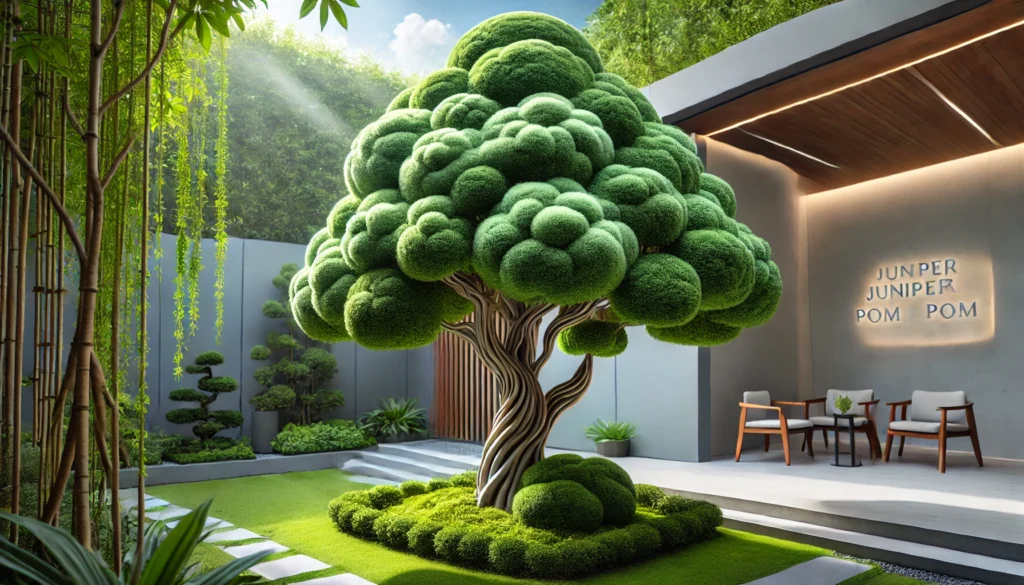
Transform Your Garden with a Juniper Pom Pom Tree: Styling Tips & Care Guide
Want to turn your yard into a bold, artistic masterpiece without the hassle of high-maintenance plants? The juniper pom pom tree might be your perfect solution 
If you’ve ever wondered how to keep your juniper pom pom tree looking polished and healthy year-round, you’re in the right place. This guide will walk you through everything from styling ideas to hands-on care tips — all beginner-friendly, easy to follow, and designed to help you transform your landscape with confidence. Let’s get started!
Table of Contents
Toggle What Is a Juniper Pom Pom Tree?
What Is a Juniper Pom Pom Tree?
A Juniper Pom Pom Tree is a unique, eye-catching way to style a standard juniper shrub into a work of art 
 Living Sculpture for Your Garden
Living Sculpture for Your Garden
Think of the Juniper Pom Pom Tree as topiary with personality! Each “pom” is shaped into a ball of soft foliage, spaced out to create visual rhythm and movement. It’s especially popular in Japanese gardens, modern landscapes, and entryways where a bit of artistic flair is welcome.
 Why Gardeners Love It
Why Gardeners Love It
- Low Maintenance: Once shaped, it grows slowly and holds its form well with minimal pruning.
- Evergreen Beauty: Stays lush and green all year long—great for year-round curb appeal.
- Space-Saving: Its vertical design makes it ideal for small gardens, patios, or front yards.
- Instant Focal Point: Just one tree can elevate the entire look of your landscape
.
 Types of Junipers Used
Types of Junipers Used
The most common varieties used for pom pom shaping include:
- Juniperus chinensis ‘Torulosa’ (Hollywood Juniper)
- Juniperus scopulorum ‘Blue Arrow’
- Juniperus squamata ‘Blue Star’
Each brings a different texture and shade of green-blue, so you can pick the one that matches your garden’s vibe.
 Bottom Line
Bottom Line
A Juniper Pom Pom Tree is a fantastic choice if you want something low-fuss but high-impact. It’s sculptural, stylish, and surprisingly easy to maintain with just a little trimming a couple of times a year.
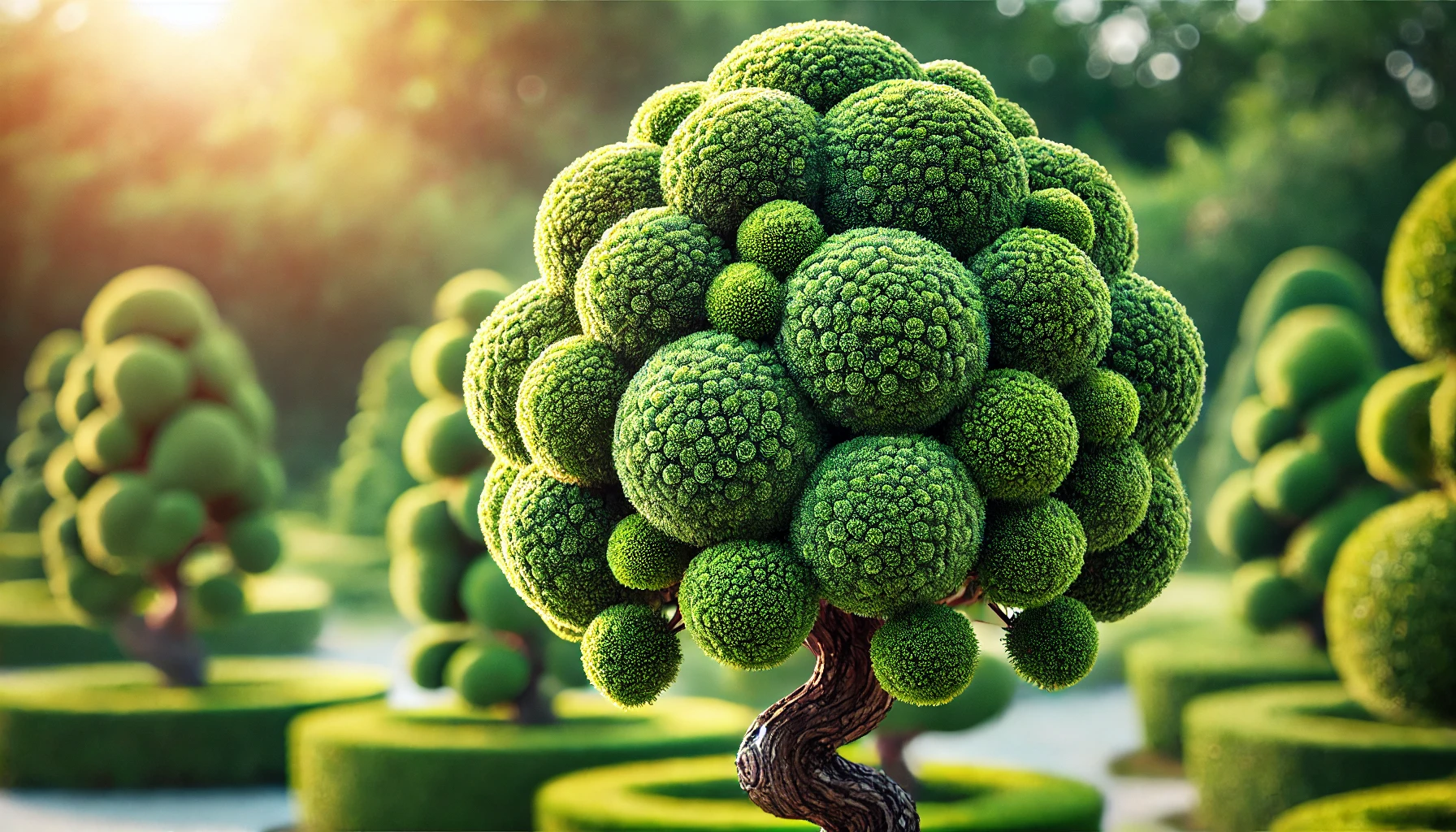
 Benefits of Adding a Juniper Pom Pom Tree to Your Garden
Benefits of Adding a Juniper Pom Pom Tree to Your Garden
Looking to add a touch of whimsy and structure to your outdoor space? The Juniper Pom Pom tree is your secret weapon 
1.  Unique Sculptural Style
Unique Sculptural Style
The pom pom shape instantly creates visual interest. It looks like living art in your garden—perfect for adding personality and elegance to modern, Japanese, or minimalist landscapes.
2.  Low Maintenance, High Impact
Low Maintenance, High Impact
Juniper Pom Pom trees are hardy, drought-tolerant, and pest-resistant. They thrive in full sun and well-drained soil, making them easy to care for—even if you’re not a seasoned gardener 
3.  Ideal for Small Spaces
Ideal for Small Spaces
Thanks to their compact form, these trees are a dream for small gardens, patios, and even balconies. You get big style in a small footprint—no need for sprawling garden beds.
4.  Perfect for Zen and Topiary Gardens
Perfect for Zen and Topiary Gardens
Their calm, orderly shape makes them a great fit for meditation corners, Japanese rock gardens, or formal topiary settings. The round “cloud” shapes bring a peaceful, balanced vibe to any space 
5.  Evergreen Beauty Year-Round
Evergreen Beauty Year-Round
Unlike deciduous trees, Juniper Pom Poms stay green through all seasons. You’ll enjoy their lush, structured look even in winter when other plants go dormant 
6.  Attracts Less Mess & More Compliments
Attracts Less Mess & More Compliments
Unlike messy trees that drop leaves or flowers, this one keeps things tidy. It also doesn’t attract many pests, so you’ll spend less time cleaning and more time admiring 
7.  Great in Pots or the Ground
Great in Pots or the Ground
Whether planted in the soil or styled in a large container, Juniper Pom Pom trees adapt beautifully. Use them to frame entryways, patios, or as standalone focal points in decorative pots.
Bottom line? A Juniper Pom Pom tree is a no-fuss, high-style addition to almost any outdoor space. Whether you’re designing a serene Zen garden or a bold front yard statement, this tree delivers both beauty and practicality 
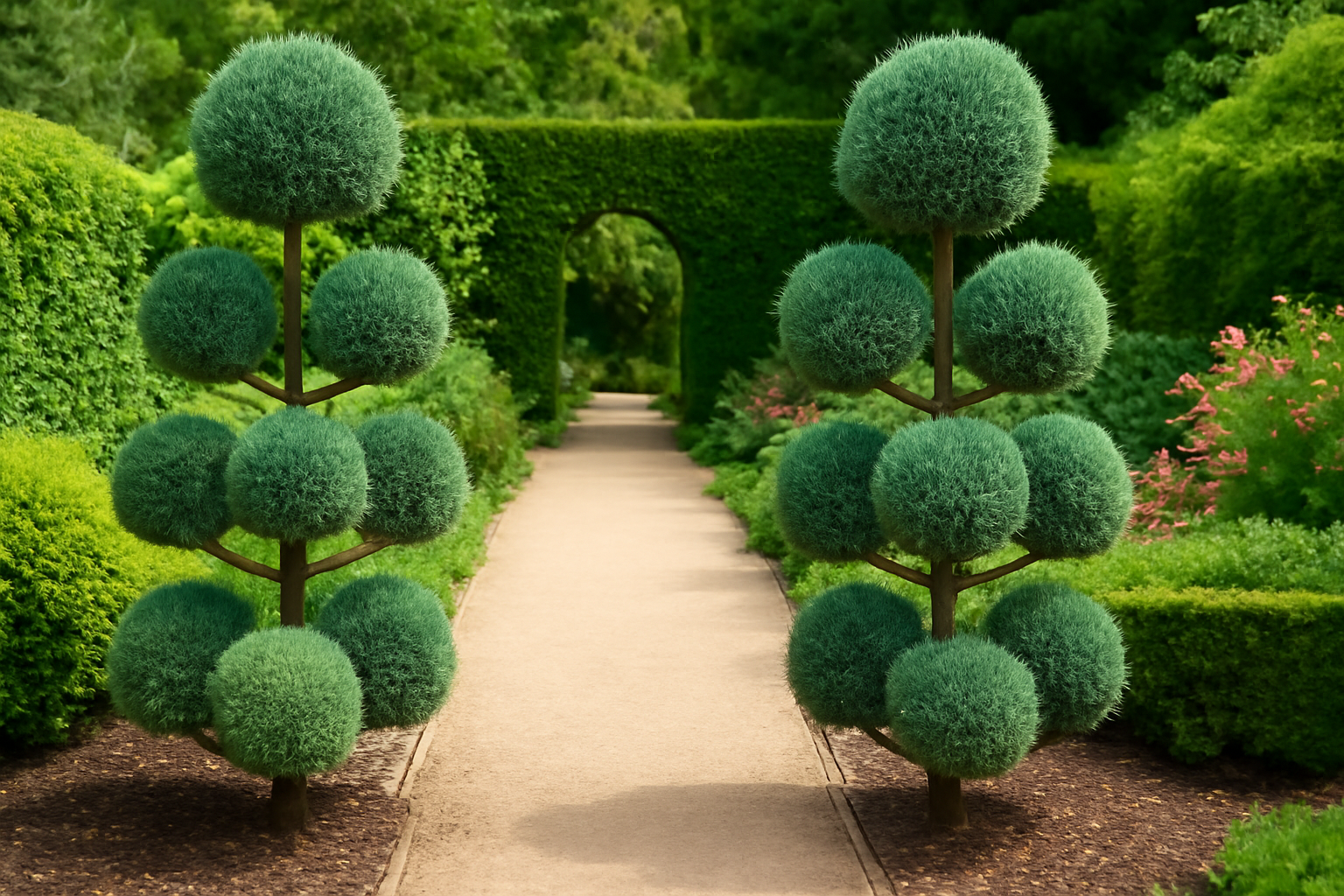
 How to Plant a Juniper Pom Pom Tree (Step-by-Step)
How to Plant a Juniper Pom Pom Tree (Step-by-Step)
Planting a Juniper Pom Pom tree isn’t hard, but doing it right ensures healthy growth and a picture-perfect shape for years to come 
 Step 1: Choose the Right Spot
Step 1: Choose the Right Spot
Pick a sunny location—Juniper Pom Poms love full sun! 

 Step 2: Prep the Area
Step 2: Prep the Area
Clear away grass, weeds, and debris. Dig a hole that’s:
- 2–3 times wider than the root ball
- Same depth as the root ball (not deeper!)
This gives the roots room to grow outward—not down too deep.
 Step 3: Remove the Tree from Its Pot
Step 3: Remove the Tree from Its Pot
Gently tip the tree on its side and slide it out of the pot. Loosen the roots around the edges with your fingers—this helps the plant “wake up” and settle into its new home.
 Step 4: Plant It Properly
Step 4: Plant It Properly
Place the tree in the center of the hole. Make sure the top of the root ball is level with the ground. Backfill with the soil you dug out, pressing gently to remove air pockets.

 Step 5: Water Deeply
Step 5: Water Deeply
Give your tree a slow, deep watering right after planting. This helps the soil settle and hydrates the roots. Keep it evenly moist (not soggy!) for the first few weeks while it adjusts.
 Step 6: Mulch to Protect
Step 6: Mulch to Protect
Spread 2–3 inches of mulch around the base to keep the soil cool and retain moisture. Leave a small gap around the trunk to prevent rot.

 Step 7: Stake if Needed
Step 7: Stake if Needed
If your tree is top-heavy or in a windy area, use stakes and soft ties to support it during the first season. Remove the supports once the roots are strong.
Final Tip 
Check on your tree regularly during the first 2–3 months. With proper planting and care, your Juniper Pom Pom will reward you with stunning, sculpted greenery year-round 

 How to Shape and Maintain the Pom Pom Style
How to Shape and Maintain the Pom Pom Style
Turning your juniper tree into a whimsical pom pom masterpiece is easier than you might think! 
 What You’ll Need
What You’ll Need
- Sharp, clean pruning shears
- Gardening gloves
- Optional: hedge trimmers for touch-ups
- A clear vision or reference photo for your pom pom design
 Step-by-Step: Shaping Your Pom Pom Juniper
Step-by-Step: Shaping Your Pom Pom Juniper
1. Choose a Healthy Tree
Start with a juniper that has a strong central trunk and multiple bushy branches. The pom pom style works best with naturally upright growth.
2. Select Your “Pom Poms”
Visualize (or mark) the spots where you want each pom pom to be. Aim for 3–5 rounded clusters spaced along the trunk, depending on the height of the tree.
3. Trim the Filler
Remove all excess foliage between the future pom poms. Cut back inner branches that clutter the shape. You want clear “gaps” between each ball to make them pop!
4. Shape the Balls
Now gently round each cluster of foliage into a ball shape. Work slowly—better to trim a little at a time than too much. Use your shears to define the curves and clean the edges.
5. Step Back Often
Take a few steps back every now and then to check your work. Symmetry matters—but perfection isn’t the goal. The charm of pom pom trees is in their character
 Ongoing Maintenance Tips
Ongoing Maintenance Tips
- Trim 2–3 times a year, especially in spring and mid-summer, to keep the shape tidy.
- Remove any new shoots between pom poms to maintain clean gaps.
- Water deeply but infrequently—junipers hate soggy roots!
- Fertilize once a year in early spring with a slow-release evergreen formula.
 Bonus Tip: Add Visual Interest
Bonus Tip: Add Visual Interest
Try staggering the size or height of your pom poms for a dynamic, bonsai-like effect. You can even use lighting at night to spotlight each ball—magical!
Shaping a juniper into the pom pom style is like creating living art. With just a little care and creativity, your garden will have a unique feature that turns heads and sparks joy year-round

 Seasonal Care Guide for Juniper Pom Pom Trees
Seasonal Care Guide for Juniper Pom Pom Trees
Keeping your Juniper Pom Pom tree healthy and stylish year-round is easy with the right seasonal care. Follow this simple guide to ensure your tree stays lush, sculpted, and thriving in every season!
 Spring: Wake-Up & Shape Up
Spring: Wake-Up & Shape Up
- Prune for Form: Spring is prime time to trim and shape your pom poms. Use clean shears to maintain that signature rounded look
.
- Feed the Tree: Apply a slow-release, balanced fertilizer to encourage healthy new growth.
- Water Wisely: As temperatures rise, water deeply once the top inch of soil feels dry—especially for newly planted trees.
- Watch for Pests: Check for spider mites or scale insects. A gentle hose-down or insecticidal soap can help.
 Summer: Maintain & Monitor
Summer: Maintain & Monitor
- Keep It Hydrated: Water consistently, especially during hot, dry spells. Mulch around the base to lock in moisture and keep roots cool.
- Light Pruning: Snip off any wayward growth to keep the pom poms neat.
- Sun Smart: Juniper loves full sun! Just make sure potted trees don’t overheat—shade the container if needed.
 Fall: Prep for Rest
Fall: Prep for Rest
- Trim Lightly: Do a gentle tidy-up prune, but avoid heavy cuts late in the season.
- Ease Off Fertilizer: Stop feeding your tree to allow it to wind down for winter.
- Clean the Base: Remove fallen leaves or debris to prevent disease or pests from settling in.
 Winter: Protect & Pause
Winter: Protect & Pause
- Water Sparingly: Only water when the soil is dry and the weather is above freezing.
- Shield from Harsh Winds: For exposed areas, wrap the base with burlap or use a windbreak to prevent desiccation.
- Potted Tree Tip: Move containers closer to a wall or inside a garage for extra insulation.
 Pro Tip:
Pro Tip:
Consistent care = consistent beauty! Stick to this routine and your Juniper Pom Pom tree will stay healthy and picture-perfect all year long 
Need help with a pruning schedule or fertilizer type? I’m here to guide you anytime!
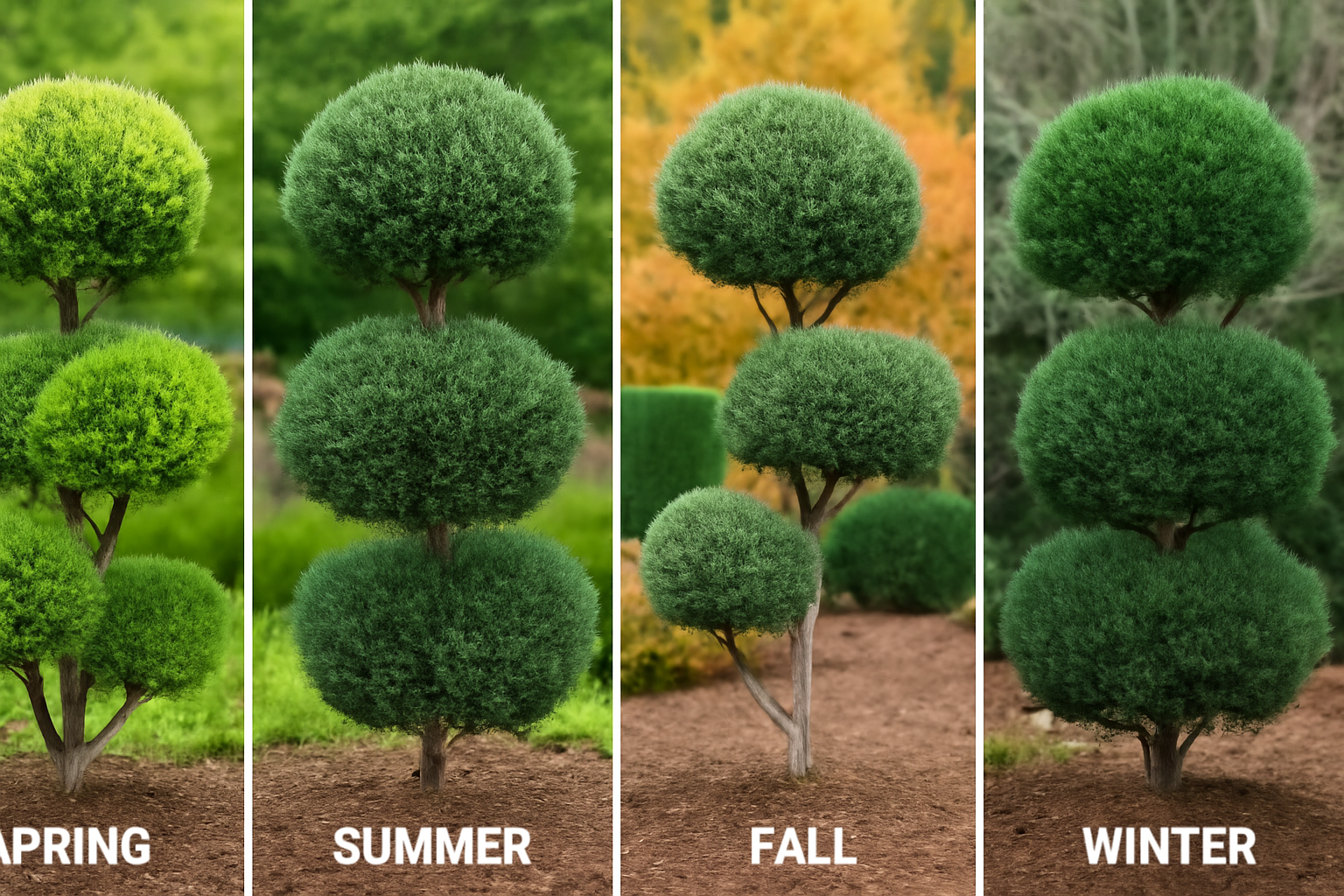
 Common Issues and How to Solve Them
Common Issues and How to Solve Them
Juniper Pom Pom trees are stunning, but like any living plant, they can run into a few bumps along the way. Don’t worry—most issues are easy to fix with the right know-how. Let’s tackle the most common problems and how to solve them effectively
1.  Yellowing or Browning Foliage
Yellowing or Browning Foliage
What it means: This is often a sign of overwatering, poor drainage, or root rot.
Fix it:
- Check the soil moisture—if it’s soggy, ease up on watering.
- Ensure your pot or planting area has good drainage holes.
- Prune away affected branches and let the soil dry out a bit.

2.  Pests Like Spider Mites or Scale
Pests Like Spider Mites or Scale
What it means: Tiny bugs sucking sap from your tree can cause dull, speckled foliage.
Fix it:
- Spray the foliage with a strong blast of water to knock off pests.
- Use insecticidal soap or neem oil weekly until the pests are gone.
- Keep the tree healthy with good airflow and avoid overcrowding.

3.  Pom Poms Losing Their Shape
Pom Poms Losing Their Shape
What it means: Lack of pruning or uneven growth can make your pom poms look a little wild.
Fix it:
- Use clean, sharp shears to lightly trim and reshape the foliage every few months.
- Follow the natural ball shape for a clean, fluffy look
.
- Prune in late spring or early fall for best results.

4.  Sunburn or Leaf Scorch
Sunburn or Leaf Scorch
What it means: Too much direct heat in very hot climates can scorch the foliage.
Fix it:
- Provide partial afternoon shade if temperatures regularly soar above 90°F (32°C).
- Mulch around the base to keep roots cool and moist.
- Water early in the day to reduce heat stress.

5.  Slow or Stunted Growth
Slow or Stunted Growth
What it means: Poor soil nutrition or rootbound conditions can hold your tree back.
Fix it:
- Fertilize once or twice a year with a balanced, slow-release fertilizer.
- If it’s in a pot, check if it’s rootbound—repot into a slightly larger container if needed.
- Keep weeds and grass away from the base to reduce competition.

Final Thought 
Most problems with Juniper Pom Pom trees are easy to fix once you understand what your tree is trying to tell you. Stay observant, prune regularly, and adjust care with the seasons—and your tree will reward you with bold, sculptural beauty all year long 
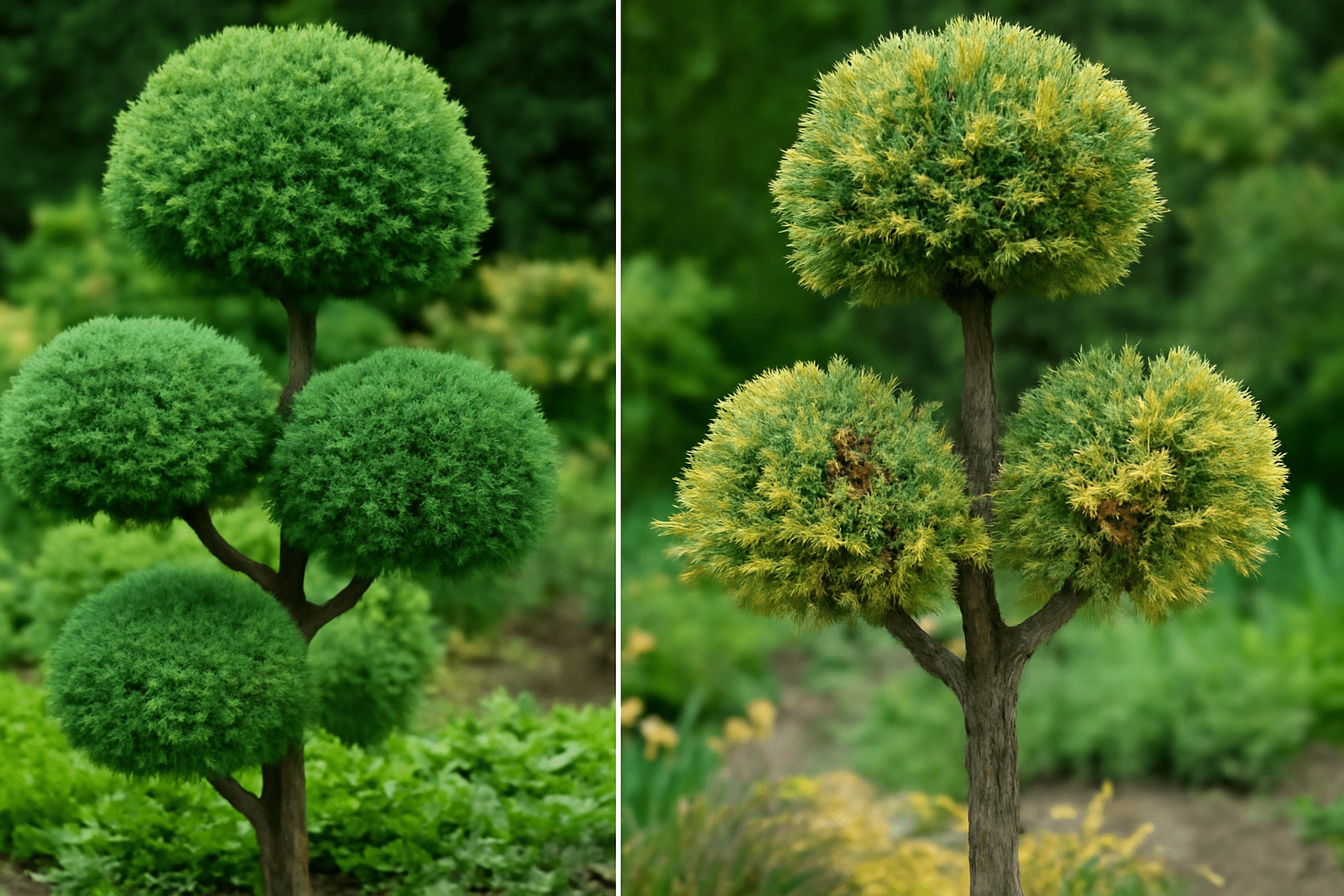
 Styling Ideas and Garden Design Inspiration
Styling Ideas and Garden Design Inspiration
The Juniper Pom Pom Tree is a living work of art—whimsical, elegant, and surprisingly versatile 
1.  Feature It in a Stylish Container
Feature It in a Stylish Container
Placing your Juniper Pom Pom in a decorative pot instantly turns it into a garden statement piece. Choose a tall, sleek planter for modern aesthetics, or a rustic terracotta one for a Mediterranean vibe. Great for patios, balconies, or small gardens!
Pro Tip: Use contrasting groundcover or trailing plants at the base to make the pom-poms pop 
2.  Flank Entrances or Pathways
Flank Entrances or Pathways
Line a garden path or frame your front door with a pair of pom pom trees for an inviting, symmetrical look. Their unique shape adds formality without feeling rigid.
Try This: Pair with low boxwoods or lavender for a polished, layered effect.
3.  Mix with Soft, Flowing Plants
Mix with Soft, Flowing Plants
Balance the structured look of pom pom trees with soft ornamental grasses, colorful perennials, or cascading flowers. This mix creates a beautiful contrast and a more natural, relaxed feel.
Ideas: Plant near salvia, coneflowers, or silver artemisia for a designer-style look.
4.  Make It a Focal Point
Make It a Focal Point
Let your Juniper Pom Pom Tree steal the spotlight! Place it solo in a gravel bed, on a raised mound, or within a circular garden design. Add lighting to highlight its sculptural form at night 
Pro Move: Surround it with smooth stones or mulch to draw the eye straight to the tree.
5.  Use in Zen or Japanese-Inspired Gardens
Use in Zen or Japanese-Inspired Gardens
The rounded form of pom pom junipers fits perfectly in minimalist, serene landscapes. Combine with rocks, moss, and sand for a tranquil, meditative setting.
Tip: Space them out thoughtfully to maintain balance and negative space—key to Zen design.
Final Styling Tips:
- Prune regularly to keep the pom-poms well-shaped and healthy
.
- Stick to odd numbers (1, 3, or 5) for a more organic, pleasing arrangement.
- Consider scale—use smaller trees in tighter spaces and larger ones to anchor open areas.
With the right styling, your Juniper Pom Pom Tree can transform any garden into a sophisticated, storybook-worthy space 
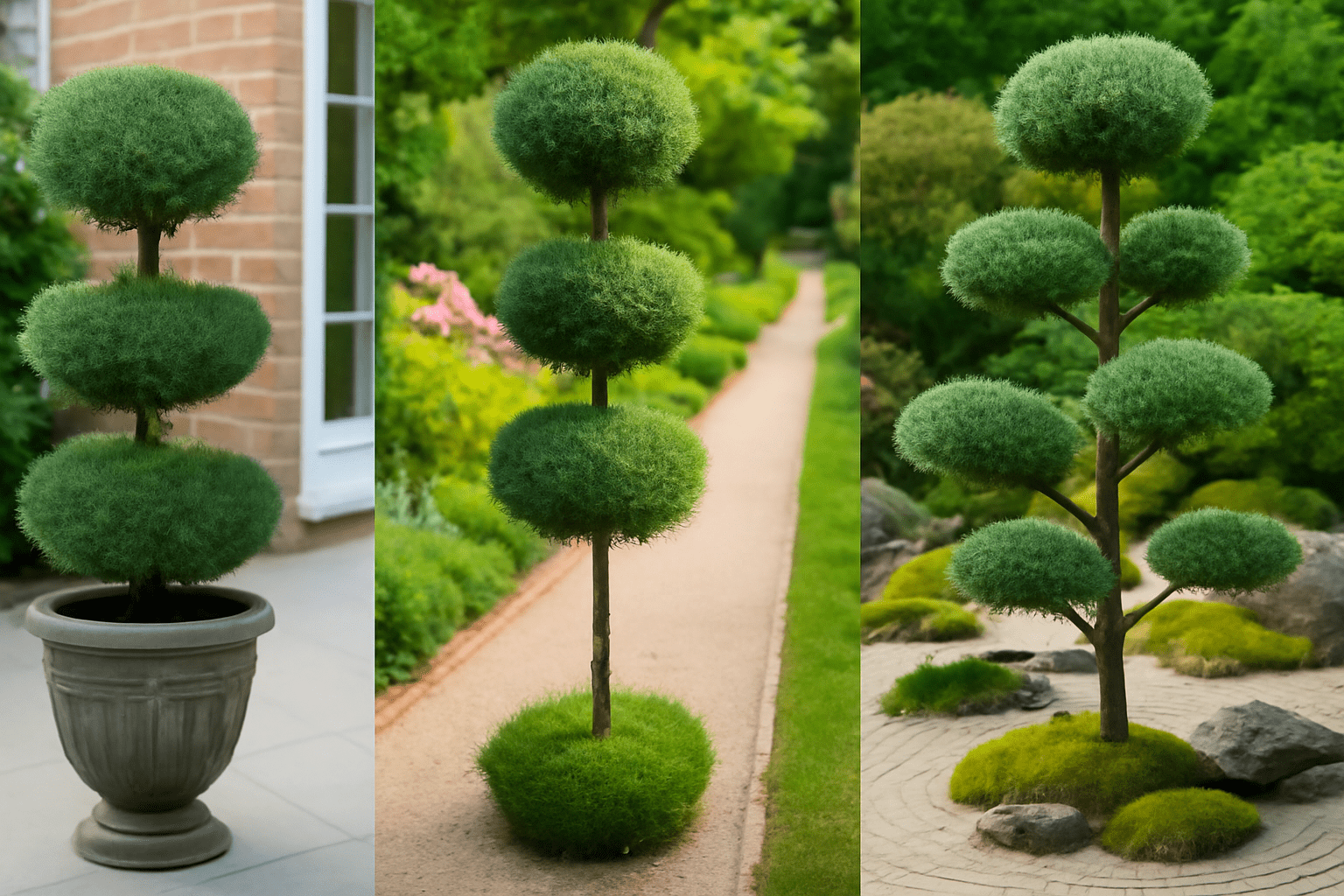
 Conclusion
Conclusion
The juniper pom pom tree is more than just a decorative plant — it’s a living sculpture that brings elegance, structure, and personality to your garden. Whether you’re enhancing your entryway, adding flair to your patio, or designing a tranquil zen space, this versatile topiary delivers high impact with surprisingly low maintenance.
By now, you’ve learned everything you need to grow, style, and care for a pom pom juniper like a pro — from planting and shaping to seasonal upkeep and troubleshooting. With just a little effort and the right tools, you can keep your tree looking bold, balanced, and beautifully pruned all year round.
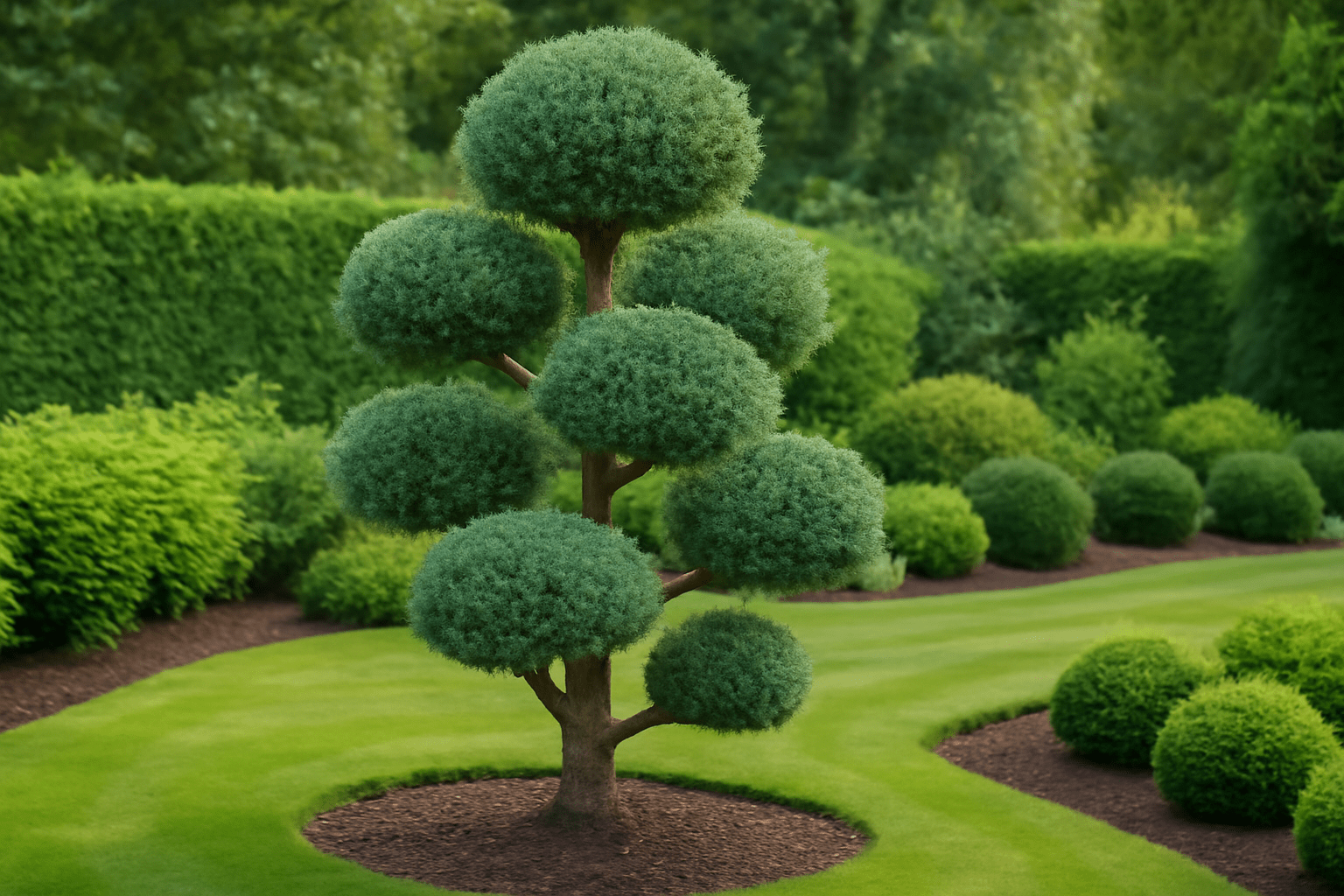
Ready to give your garden a fresh, artistic touch? Start shaping your own juniper pom pom tree today — and let your landscape reflect your unique style and creativity.
Frequently Asked Questions(FAQ)
What is a juniper pom pom tree?
A juniper pom pom tree is a type of topiary where the evergreen foliage is pruned into round, cloud-like clusters along the trunk. It’s commonly used in ornamental landscaping to create a structured, artistic look.
How do you shape a juniper pom pom tree?
Use clean, sharp pruning shears to trim the foliage into rounded balls (pom poms), spaced out along the trunk or main branches. Trim regularly, 2–3 times a year, and follow a guide if you’re shaping for the first time.
How often should I prune my juniper pom pom tree?
Prune your pom pom tree about two to three times a year — typically in late spring, midsummer, and early fall. Regular pruning helps maintain the shape and encourages dense, healthy growth.
Can I grow a juniper pom pom tree in a pot?
Yes, juniper pom pom trees do well in large containers with good drainage. Use quality potting soil, water deeply when the top inch of soil is dry, and place the pot in full sun.
What kind of soil does a juniper pom pom tree need?
Junipers prefer well-draining soil, such as sandy or loamy soil. Avoid heavy clay or constantly wet areas, as poor drainage can cause root rot and other issues.
How much sunlight does a juniper pom pom tree need?
These trees thrive in full sun — at least 6 to 8 hours of direct sunlight each day. Too much shade can result in leggy growth and sparse foliage.
Why are the pom poms on my juniper turning brown?
Browning can be caused by overwatering, poor drainage, pests, or harsh weather. Check the soil moisture, look for spider mites or bagworms, and prune away damaged foliage to promote recovery.
Is a juniper pom pom tree hard to maintain?
Not at all. Once established, it’s low-maintenance and drought-tolerant. With occasional pruning and proper placement, it remains a beautiful focal point year-round with minimal effort.



